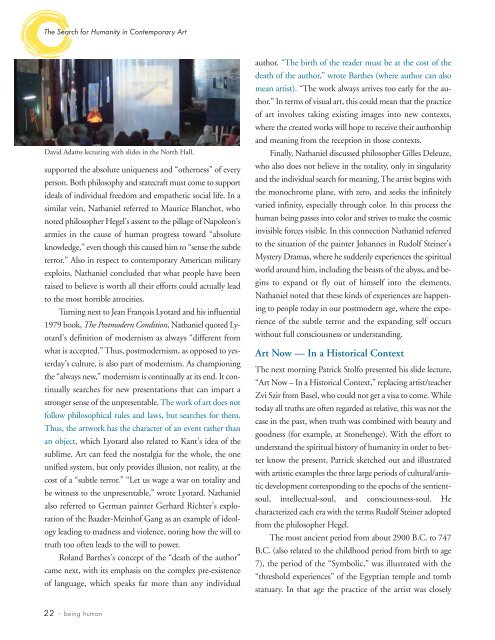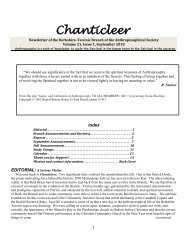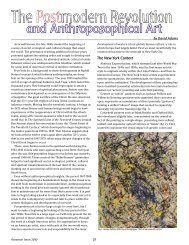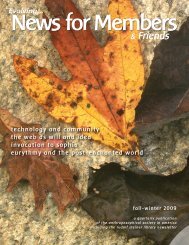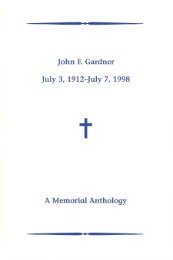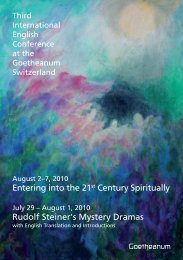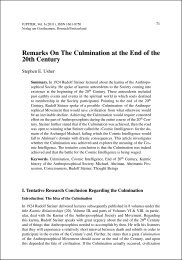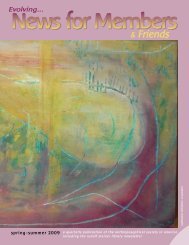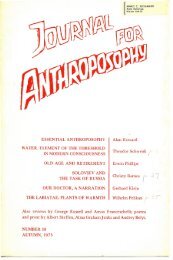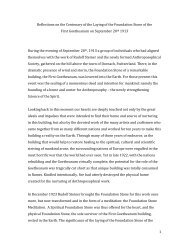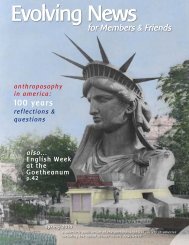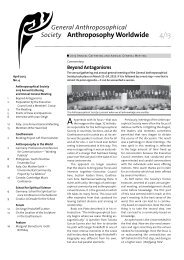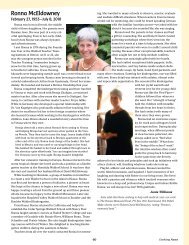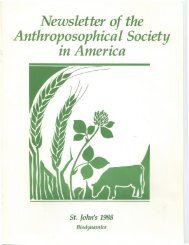Rudolf Steiner's Vision for the Future - Anthroposophical Society in ...
Rudolf Steiner's Vision for the Future - Anthroposophical Society in ...
Rudolf Steiner's Vision for the Future - Anthroposophical Society in ...
Create successful ePaper yourself
Turn your PDF publications into a flip-book with our unique Google optimized e-Paper software.
The Search <strong>for</strong> Humanity <strong>in</strong> Contemporary Art<br />
David Adams lectur<strong>in</strong>g with slides <strong>in</strong> <strong>the</strong> North Hall.<br />
supported <strong>the</strong> absolute uniqueness and “o<strong>the</strong>rness” of every<br />
person. Both philosophy and statecraft must come to support<br />
ideals of <strong>in</strong>dividual freedom and empa<strong>the</strong>tic social life. In a<br />
similar ve<strong>in</strong>, Nathaniel referred to Maurice Blanchot, who<br />
noted philosopher Hegel’s assent to <strong>the</strong> pillage of Napoleon’s<br />
armies <strong>in</strong> <strong>the</strong> cause of human progress toward “absolute<br />
knowledge,” even though this caused him to “sense <strong>the</strong> subtle<br />
terror.” Also <strong>in</strong> respect to contemporary American military<br />
exploits, Nathaniel concluded that what people have been<br />
raised to believe is worth all <strong>the</strong>ir ef<strong>for</strong>ts could actually lead<br />
to <strong>the</strong> most horrible atrocities.<br />
Turn<strong>in</strong>g next to Jean François Lyotard and his <strong>in</strong>fluential<br />
1979 book, The Postmodern Condition, Nathaniel quoted Lyotard’s<br />
def<strong>in</strong>ition of modernism as always “different from<br />
what is accepted.” Thus, postmodernism, as opposed to yesterday’s<br />
culture, is also part of modernism. As champion<strong>in</strong>g<br />
<strong>the</strong> “always new,” modernism is cont<strong>in</strong>ually at its end. It cont<strong>in</strong>ually<br />
searches <strong>for</strong> new presentations that can impart a<br />
stronger sense of <strong>the</strong> unpresentable. The work of art does not<br />
follow philosophical rules and laws, but searches <strong>for</strong> <strong>the</strong>m.<br />
Thus, <strong>the</strong> artwork has <strong>the</strong> character of an event ra<strong>the</strong>r than<br />
an object, which Lyotard also related to Kant’s idea of <strong>the</strong><br />
sublime. Art can feed <strong>the</strong> nostalgia <strong>for</strong> <strong>the</strong> whole, <strong>the</strong> one<br />
unified system, but only provides illusion, not reality, at <strong>the</strong><br />
cost of a “subtle terror.” “Let us wage a war on totality and<br />
be witness to <strong>the</strong> unpresentable,” wrote Lyotard. Nathaniel<br />
also referred to German pa<strong>in</strong>ter Gerhard Richter’s exploration<br />
of <strong>the</strong> Baader-Me<strong>in</strong>hof Gang as an example of ideology<br />
lead<strong>in</strong>g to madness and violence, not<strong>in</strong>g how <strong>the</strong> will to<br />
truth too often leads to <strong>the</strong> will to power.<br />
Roland Bar<strong>the</strong>s’s concept of <strong>the</strong> “death of <strong>the</strong> author”<br />
came next, with its emphasis on <strong>the</strong> complex pre-existence<br />
of language, which speaks far more than any <strong>in</strong>dividual<br />
22 • be<strong>in</strong>g human<br />
author. “The birth of <strong>the</strong> reader must be at <strong>the</strong> cost of <strong>the</strong><br />
death of <strong>the</strong> author,” wrote Bar<strong>the</strong>s (where author can also<br />
mean artist). “The work always arrives too early <strong>for</strong> <strong>the</strong> author.”<br />
In terms of visual art, this could mean that <strong>the</strong> practice<br />
of art <strong>in</strong>volves tak<strong>in</strong>g exist<strong>in</strong>g images <strong>in</strong>to new contexts,<br />
where <strong>the</strong> created works will hope to receive <strong>the</strong>ir authorship<br />
and mean<strong>in</strong>g from <strong>the</strong> reception <strong>in</strong> those contexts.<br />
F<strong>in</strong>ally, Nathaniel discussed philosopher Gilles Deleuze,<br />
who also does not believe <strong>in</strong> <strong>the</strong> totality, only <strong>in</strong> s<strong>in</strong>gularity<br />
and <strong>the</strong> <strong>in</strong>dividual search <strong>for</strong> mean<strong>in</strong>g. The artist beg<strong>in</strong>s with<br />
<strong>the</strong> monochrome plane, with zero, and seeks <strong>the</strong> <strong>in</strong>f<strong>in</strong>itely<br />
varied <strong>in</strong>f<strong>in</strong>ity, especially through color. In this process <strong>the</strong><br />
human be<strong>in</strong>g passes <strong>in</strong>to color and strives to make <strong>the</strong> cosmic<br />
<strong>in</strong>visible <strong>for</strong>ces visible. In this connection Nathaniel referred<br />
to <strong>the</strong> situation of <strong>the</strong> pa<strong>in</strong>ter Johannes <strong>in</strong> <strong>Rudolf</strong> Ste<strong>in</strong>er’s<br />
Mystery Dramas, where he suddenly experiences <strong>the</strong> spiritual<br />
world around him, <strong>in</strong>clud<strong>in</strong>g <strong>the</strong> beasts of <strong>the</strong> abyss, and beg<strong>in</strong>s<br />
to expand or fly out of himself <strong>in</strong>to <strong>the</strong> elements.<br />
Nathaniel noted that <strong>the</strong>se k<strong>in</strong>ds of experiences are happen<strong>in</strong>g<br />
to people today <strong>in</strong> our postmodern age, where <strong>the</strong> experience<br />
of <strong>the</strong> subtle terror and <strong>the</strong> expand<strong>in</strong>g self occurs<br />
without full consciousness or understand<strong>in</strong>g.<br />
Art Now — In a Historical Context<br />
The next morn<strong>in</strong>g Patrick Stolfo presented his slide lecture,<br />
“Art Now – In a Historical Context,” replac<strong>in</strong>g artist/teacher<br />
Zvi Szir from Basel, who could not get a visa to come. While<br />
today all truths are often regarded as relative, this was not <strong>the</strong><br />
case <strong>in</strong> <strong>the</strong> past, when truth was comb<strong>in</strong>ed with beauty and<br />
goodness (<strong>for</strong> example, at Stonehenge). With <strong>the</strong> ef<strong>for</strong>t to<br />
understand <strong>the</strong> spiritual history of humanity <strong>in</strong> order to better<br />
know <strong>the</strong> present, Patrick sketched out and illustrated<br />
with artistic examples <strong>the</strong> three large periods of cultural/artistic<br />
development correspond<strong>in</strong>g to <strong>the</strong> epochs of <strong>the</strong> sentientsoul,<br />
<strong>in</strong>tellectual-soul, and consciousness-soul. He<br />
characterized each era with <strong>the</strong> terms <strong>Rudolf</strong> Ste<strong>in</strong>er adopted<br />
from <strong>the</strong> philosopher Hegel.<br />
The most ancient period from about 2900 B.C. to 747<br />
B.C. (also related to <strong>the</strong> childhood period from birth to age<br />
7), <strong>the</strong> period of <strong>the</strong> “Symbolic,” was illustrated with <strong>the</strong><br />
“threshold experiences” of <strong>the</strong> Egyptian temple and tomb<br />
statuary. In that age <strong>the</strong> practice of <strong>the</strong> artist was closely


